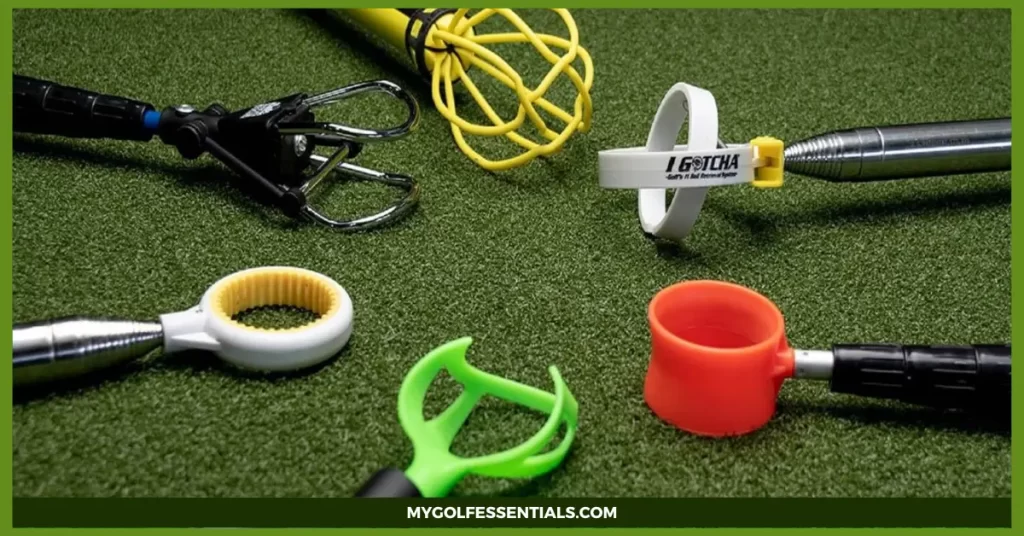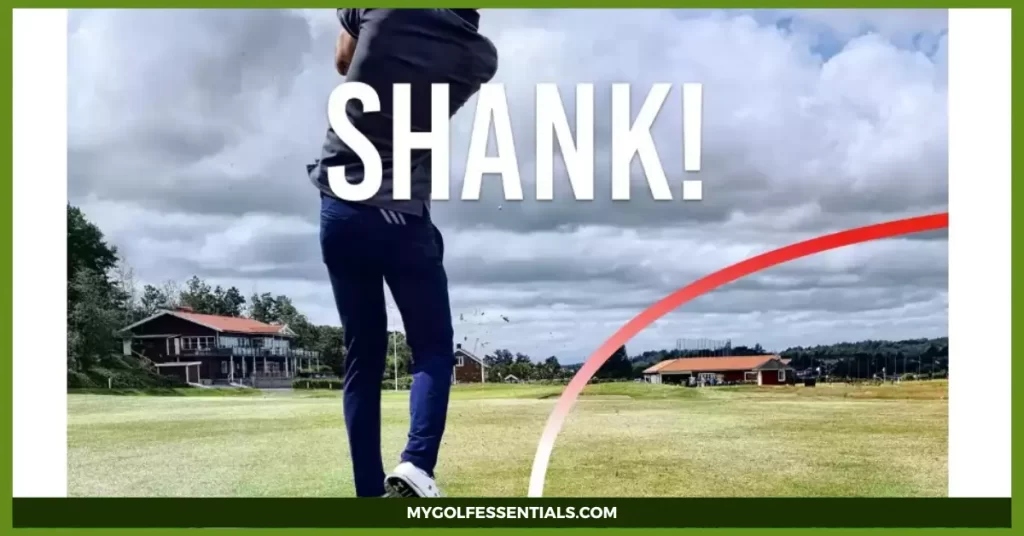
Are you a golfer that experiences the dreaded ‘shank’? Every golf enthusiast has had their fair share of shots that go awry, and it can feel especially disheartening when one lands on the shanking end of the spectrum. Many believe that a shanked shot is due to bad luck.
However, there are various underlying reasons why your ball may have deviated drastically from its intended route. This post will provide an in-depth overview of what causes a shank in golf and helpful tips to reduce the chances of future mishaps. Read on for more information!
What Is A Shank?
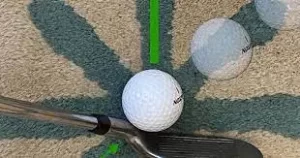
A shank is a shot in golf where the ball veers sharply to the right of the intended target. It occurs when the golfer makes contact with the ball with a part of their club not designed to hit it, usually on or near an iron’s heel (the far side). This results in a significantly shorter shot than expected and often goes off in an unexpected direction.
The term shank can also refer to other less common types of shots, such as a shot that travels straight to the right or left of the target (known as “pulling” or “pushing,” respectively). Shanks are often caused by incorrect grip angle, poor alignment, stance changes, and even grip pressure. It’s important to detect and address the root cause of a shank, as it can be difficult to fix if left unchecked.
Some golfers have even experienced career-altering “shanking streaks” because they cannot properly identify and eliminate their shanks. Working with a professional instructor or taking lessons from a qualified teaching professional is often necessary toto make the proper adjustments and correct the shank before it becomes more serious or permanently damages a golfer’s confidence.
Identifying the Causes of a Shank in Golf
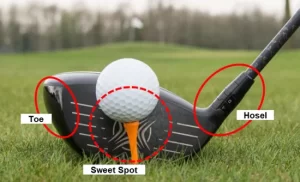
A shank in golf is a devastating shot that often results in an unexpected, misdirected ball flight and can ruin any round. It has been described as the most abhorred golfing experience due to its unpredictability. At the same time, it might seem like something that randomly happens, but several causes of the shank in golf will help you identify why this misfortune has befallen you.
The most common cause of shank in golf is an incorrect setup or swing path. It occurs when a golfer sets up too close to the ball, creates a steep downward angle with their clubhead, and brings the club too far inside on the backswing. This causes the outermost part or toe of the clubface to strike the golf ball rather than the center or sweet spot. It’s a common mistake that can happen to any golfer and is usually easy to fix.
Another cause of shank in golf is an incorrect grip on the club. If your hands are too deep or far away from the club handle, it can affect your swing path and cause you to hit the ball off-center. A weak grip can also lead to a “fade” or “slice” in your shot, another shank form.
Practicing the Correct Swing Techniques to Avoid Shank
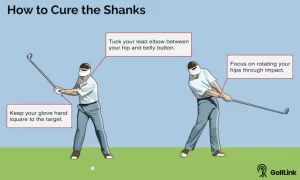
Most players are familiar with the dreaded shank on the golf course. A shank occurs when a golfer strikes the ball with the heel of their club, sending it off in an unintended direction, usually resulting in lost strokes and frustration.
Although shanks may seem impossible to avoid once they begin occurring, there are several techniques players can use to help them avoid the dreaded shank. Here are some tips for practicing to decrease the likelihood of shaking:
– Pay close attention to your grip: Make sure the club is firmly and evenly held in both hands, with your palms facing each other. This will help prevent your wrists from breaking down during the swing and reduce the possibility of shaking.
– Maintain an open stance: Position your feet and hips slightly open to the target instead of having them closed. This will allow you to better keep your weight evenly through the downswing and prevent any slide toward the heel during impact.
– Keep your head still: Maintaining proper head position throughout the swing is important. Keep your head still and focused on the ball throughout the entire swing, as any movement or swaying will cause your club to come up too steeply and be more likely to strike with the heel instead of the sweet spot.
What causes the shank to happen?
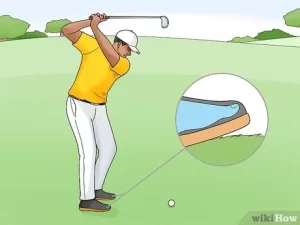
The shank is one of the most dreaded shots in golf because it can be very difficult to control or recover from. The cause of a shank is usually an incorrect impact position between the clubface and the ball. Common causes include:
– Improper weight shift during the swing – If you are overly focused on shifting your weight forward onto your left foot during the downswing, your right shoulder can rise too quickly, resulting in a severe out-to-in swing path. This shift causes the clubface to be open as it approaches the ball at impact, leading to a shank.
– Poor grip pressure – If you’re gripping the club too tightly or with an incorrect grip pressure strategy, this can cause your clubface to be closed at impact and result in a shank.
– Incorrect alignment – If you’re not aligned correctly before the swing, this can throw off your timing and lead to an outside in-swing path, which will cause the ball to go right off the target (for right-handed golfers). This misalignment leads to poor contact with the ball and a shank.
– Weak grip – If you have a weak grip on the golf club, this will tend to cause your arms to rotate too quickly during the swing resulting in an out-to-in swing path and a closed clubface at impact. This will result in a shank.
Easy Drills to Show You How to Cure Shanks
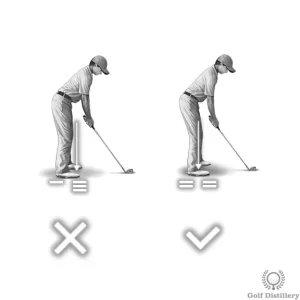
The shank in golf is a common swing issue that can be identified easily. It occurs when the golfer strikes the ball with the hosel of their club, usually resulting in an off-target and often disastrous shot. Though frustrating, this issue can be corrected with practice and consistency. Here are some great drill to help you cure shanks:
1. Tee Drill – Set up a tee at the end of your golf club. When you swing, ensure that the sweet spot in the middle of the club face is striking the ball.
2. Floppy Wrist Drill – Once you have positioned yourself on the tee box with your feet slightly apart, keep your wrists loose and floppy as you swing. This will allow the club to move more freely and prevent shank shots.
3. Swing Path Drill – Place a teed-up golf ball on a flat surface, like grass or carpeting. Take your normal stance, but this time focus on keeping your club’s head moving along a straight path through impact with the ball. This will help you stay on track with your swing and prevent the club from going offline.
By practicing these drills regularly, you can correct your shanks and improve your golf game. Remember, a consistent practice routine is key to correcting any problem in the golf swing, so make sure that you stick with it!
How to Cure a Case of the Shanking Wedges
Shanking wedge is a common problem for golfers, but there are ways to help cure it. The shank occurs when the club face strikes the ball off-center and shoots it in an unwanted direction. It’s one of the worst shots you can make, so here are some tips to help you get it fixed:
1. Make sure your grip is correct. If your hands are too far forward on the club and your grip is too strong, you can cause a shank. A neutral or weak grip should be used with the hands slightly behind the clubface.
2. Check your stance. Ensure your weight is distributed more on your front foot than just 50/50 between both feet; this will help prevent the club from coming over the top and striking the ball off-center.
3. Practice hitting a draw. Focus on swinging inside out while ensuring your clubface stays square throughout your swing. This will help you hit a controlled fade or draw instead of shanking it with an open face.
4. Check your alignment and ball position. Ensure that you are square to the ball to target line and that your ball is slightly forward in your stance. This will help avoid contact off the toe of the club and shanking it out to the right (for right-handed players).
5. Don’t rush your shots. Take a few extra practice swings before hitting, focusing on making a full shoulder turn and keeping your arms straight. This will help you create more club head speed and avoid the urge to flick at the ball with an open face.
A common problem for golfers is Shanking wedge, but it can be fixed by following these simple tips. With practice and patience, you should be able to improve your accuracy and consistency off the tee and have fewer shanks in your golf game.
How to Bounce Back After a Shank
One of the most disastrous shots a golfer can make is the shank. A shank occurs when the ball is struck off-center and ricochets sharply off to the right (for right-handed golfers) or left (for left-handed golfers). Unfortunately, golf shanks can be all too common in golfing rounds. It’s important to remain calm and positive after making a shank because it can recover from these shots. Here are some tips for bouncing back after a shank:
1. Take a deep breath. Shanking the ball can be extremely frustrating, but allowing yourself time to take a few deep breaths and regain composure can help you stay focused on your next shot.
2. Reset your stance and swing. After a shank, resetting your feet and club position is important to correct your incorrect motion on the previous shot. Ensure your posture and grip on the club sound before beginning your next swing.
3. Visualize success. Imagine yourself making a successful swing and knowing it’s possible to recover from a shank. Visualizing a successful shot can help you stay confident and positive.
4. Go for an easier club. If you second-guess your next move, opt for an easier club with less loft to minimize the chances of shanking again. A flat-faced club, such as a 6-iron or 7-iron, can be easier to hit and more likely to keep the ball on the fairway.
Hands Moving Too Far Away From Your Body
One major mistake that can lead to a shank in golf is when the hands move too far away from your body during the swing. When your hands get too far away, it can cause you to come into contact with the ball off-center, resulting in a shank. To ensure that your hands remain close to your body, focus on keeping your elbows tucked in closely to your body as you swing.
Not only will this help you avoid a shank, but it can also improve the accuracy of your golf swing. Additionally, ensure your hands stay at the same level throughout the swing and don’t drop too low during backswing or follow-through. This will ensure you maintain correct contact with the ball for a powerful and accurate shot.
As you can see, understanding how to avoid the shank in golf is key to bettering your game. With some practice and focus on controlling your body during the swing, you can hit more consistent shots and reduce your chances of consistently hitting a dreaded shank.
Standing Too Far Away From The Ball At the Address
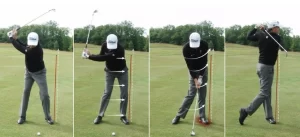
A proper stance and distance from the ball are important when addressing the ball. One of the more common errors among amateur golfers is standing too far away from the ball at the address. This could be caused by several factors, such as incorrect posture or inadequate understanding of club length about one’s body size.
A “shank,” when the ball is struck with the club’s hosel, results from standing too far away from the ball at the address. The further away you are from the ball, the more difficult it is to make contact in the center of the club’s face. To prevent shanking your shots, take shorter steps toward the ball until you find a comfortable spot to make solid contact.
Remembering that different clubs require different stances and setups at the address position is also important. For example, a driver typically requires a wider stance than an iron. When in doubt, take a practice swing and adjust accordingly until you find the distance from the ball that works best for you. A professional golf instructor can be a great resource for improving your setup and overall game.
FAQs
How does a shank in golf happen?
A golf shank is an errant shot when the ball is hit with the club’s heel, causing it to veer sharply and uncontrollably off to the right (for a right-handed player). This typically occurs when a golfer makes an outside-in swing or swings too hard. To avoid a shank, it is important to keep the head of the club down and rotate your hips properly during the swing.
What are the consequences of a shank?
A shank can lead to frustration, decreased confidence, and increased scores. Depending on the severity of the shot, it may also result in physical damage to your club straight and an inability to complete the hole. For these reasons, it is important to recognize when you are at risk of hitting a shank and adjust your swing accordingly.
How can I avoid a shank?
To avoid a shank, it is important to keep the head of the club down and rotate your hips properly during the swing. Additionally, it would be best to focus on making an inside-out swing with minimal lateral movement throughout. Finally, make sure you use enough force to generate sufficient power but not so much that you lose control.
Is there a way to correct a shank?
Yes, the best way to correct a shank is by focusing on making an inside-out swing and ensuring you keep the head of the club down at all times. Additionally, it is important to focus on your stance and grip during your swing; if you have poor posture or an incorrect grip, this can contribute to a shank.
Conclusion
I hope this article has given you a better understanding of what a shank in golf is and how it can be prevented. A shank is when your golf shot goes off to the right (for a right-handed golfer) instead of straight down the fairway. It’s important to ensure your club path is square to the ball at impact to prevent shaking. It’s also important to focus on your grip, stance, and swing path issues to ensure proper technique.

